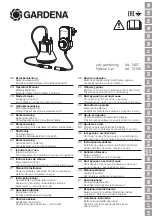
Electrical System Quick Checks
Battery Test (Open Circuit Test)
Use a multimeter to measure the voltage between the
battery terminals.
Set the multimeter to the DC volts setting. The battery
should be at a temperature of 60
o
to 100
o
F (16
o
to 38
o
C). The ignition key should be in the OFF position and
all accessories turned off. Connect the positive (+) me-
ter lead to the positive battery post and the negative (–)
meter lead to the negative battery post. Use the table to
the right to determine charge level of the battery.
Note:
This test provides a relative condition of the bat-
tery. Load testing of the battery will provide additional
and more accurate information.
Charging System Test
This is a simple test used to determine if the charging
system is functioning. It will tell you if the charging sys-
tem has an output, but not its capacity.
Use a multimeter set to the DC volts position. Connect
the positive (+) meter lead to the positive battery post
and the negative (–) meter lead to the negative battery
post. Leave the multimeter test leads connected to the
battery and record the battery voltage.
Note:
Upon starting the engine, the battery voltage
will drop and then should increase once the engine is
running.
Note:
Depending upon the condition of the battery
charge and battery temperature, the charging system
voltage will increase at different rates as the battery
charges.
Start the engine and run at high idle speed. Allow the
battery to charge for at least three (3) minutes. Record
the battery voltage.
Voltage Measured
Battery Charge Level
12.68 v (or higher)
Fully charged (100%)
12.45 v
75% charged
12.24 v
50% charged
12.06 v
25% charged
11.89 v
0% charged
After allowing the engine to run for at least three (3) min-
utes, battery voltage should be at least 0.5 volts higher
than initial battery voltage (see example in table to the
right).
Note:
While engine is running, if battery voltage ex-
ceeds 16 volts, the regulator in the charging system
should be inspected.
After allowing the engine to run for at least three (3) min-
utes, if battery voltage does not increase at least 0.5
volts, additional testing of the battery and/or charging
system should be performed.
Acceptable voltage increase:
Initial Battery Voltage
= 12.25 v
Battery Voltage after 3 Minute Charge
= 12.80 v
Difference
= +0.55 v
Glow Plug System Test (Groundsmaster 328–D)
This is a fast, simple test that can help to determine the
ter pickup around the main glow plug power supply wire.
integrity and operation of the Groundsmaster 328–D
Adjust the meter to read zero (if applicable). Cycle the
glow plug system. The test should be run anytime hard
glow plug system at least two times (per instructions in
starting (cold engine) is encountered on a diesel engine
Traction Unit Operator’s Manual) and record the final re-
equipped with a glow plug system.
sults.
Use a digital multimeter and/or inductive Ammeter (AC/
The Groundsmaster 328–D glow plug system should
DC Current Transducer) set to the correct scale. With
have a reading of approximately 27 Amps. If low current
the ignition switch in the OFF position, place the amme-
reading is observed, one (or more) glow plugs is faulty.
Groundsmaster 300 Series
Page 6A – 3
Electrical System (Rev. G)
Summary of Contents for Groundsmaster 328-D
Page 2: ......
Page 12: ...Torque Specifications Page 2 4 Rev A Groundsmaster 300 Series ...
Page 44: ...Troubleshooting Page 4 16 Groundsmaster 300 Series ...
Page 45: ...Groundsmaster 300 Series Page 4 17 Troubleshooting ...
Page 171: ...Groundsmaster 300 Series Page 6 25 Testing ...
Page 220: ...Repairs Page 7 24 Groundsmaster 300 Series ...
Page 320: ...Troubleshooting Troubleshooting Page 11 4 Groundsmaster 300 Series ...
Page 348: ...Troubleshooting Troubleshooting Page 12 4 Groundsmaster 300 Series ...
Page 379: ...Troubleshooting Groundsmaster 300 Series Page 13 3 Troubleshooting ...
Page 400: ...This page is blank ...
Page 401: ...This page is blank ...















































